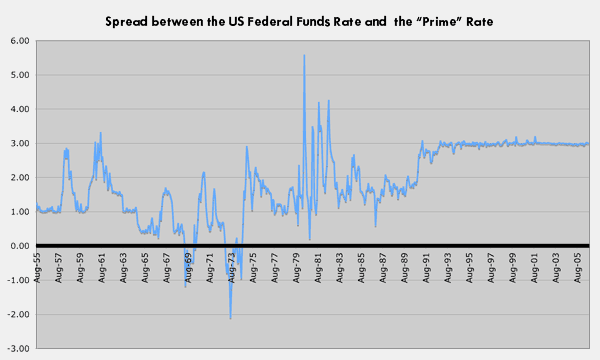While researching something quite subtle (more on that tomorrow), I noticed something not at all subtle. Below is a graph showing the spread between the US Federal Funds Rate and the so-called "Prime Rate". Do you notice a change in this series around 1991?
When I was a kid, the "prime rate" was something they announced on the news like it was something important. They don't do that any more, because the prime rate no longer is important. The prime rate is supposedly "the interest rate charged by banks to their most creditworthy customers (usually the most prominent and stable business customers)". But the most prominent businesses no longer benchmark their loans against the prime rate. They use LIBOR instead. Only consumer and small business loans are typically indexed against Prime. LIBOR became prominent, well, around the early nineties I think.
Floating rate loans, whether to companies are consumers, are usually quoted as a benchmark rate plus a spread. Check your credit card documents: Your monthly interest rates are probably something like "the Prime Rate plus 3%".
Now look at the graph above. The average spread between the Federal Funds Rate and the Prime Rate from August 1955 through August 1989 was 1.33%. From 1991 onward, that spread has been nearly constant at 3%. In the earlier period, the Prime Rate spread was what one would expect it to be, a variable, market-determined quantity reflecting the availability of capital and perceptions of risk even among "creditworthy" borrowers. Now it is a fixed quantity, more than double its average prior to 1989. At around the same time, sophisticated borrowers switched to an entirely different benchmark, leaving consumers and small businesses to pay the higher spread.
Of course, a benchmark is only a benchmark, and the various short-term dollar interest rates correlate strongly. In theory, a competitive lending market should force down bottom line rates, regardless of which benchmark is chosen. Nothing prevents a loan from being quoted as "Prime minus 1.5%". But in practice, this doesn't happen. Sophisticated consumers who know what the Prime Rate is supposed to mean understand that they should expect to pay a bit more than banks' "most creditworthy, prominent, and stable business customers". But I'll bet that 99% of educated borrowers have no idea that the Prime Rate includes a spread roughly double what those best business customers actually pay. The Prime Rate to Federal Funds spread is now fixed, in both senses of the word.
Update: A bit of web searching turns up this (by Michael Evans):
...the spread between the Federal funds (and Treasury bill) rate and the prime rate widened from 1 1/2% to 3% in 1991. That was Greenspan's gift to the banking sector to insure that major banks would not fail. You may recall at the time that rumors were rife — including some repeaed on the floor of the House — that Citibank was about to go under. By doubling the margin between the prime and the funds rate — and essentially increasing the profitability fourfold after taking into consideration the costs of processing loans — an inverted yield spread lost all its meaning. And it will never return.
Update (October, 2008): "Prime-minus" loans did eventually come to be advertised, for secured consumer credit. The first time I ever saw one was sometime in 2007 or 2008. Most consumer loans remain "prime plus", though. The 3% fixed prime rate is a gift that keeps on giving.
| Steve Randy Waldman — Monday October 9, 2006 at 11:43pm | permalink |


1991 - Double prime rate... to save the banks from '01 recession.
1993-5 - Largely stop enforcing the reserves fraction (really, a legacy of the 90/91 recession, so... to save banks).
1998 - Ignore LTCM collapse (in fact, dismiss 400 tonnes of gold owed to the Fed)... to save the economy (banks).
2001 - Crater interest rates and increase liquidity, to save the banks. I mean economy.
2001-2005 - Ignore the housing bubble, encourage ARMs and turn a blind eye to exotic lending, to ease the stock market collapse and '01 recession (by ensuring the banks will be taken care of).
Goodness... I wonder what they have left. Direct payoffs? Market plunge protection, perhaps--given how dependent banks are now upon such questionable beasts as home builders, hedge funds, and securitized exotic and low-APR mortgages.